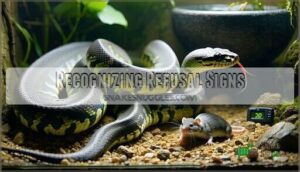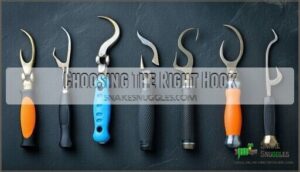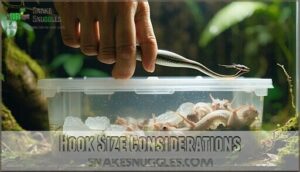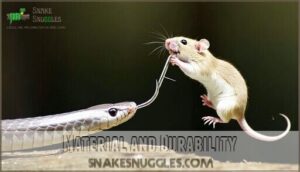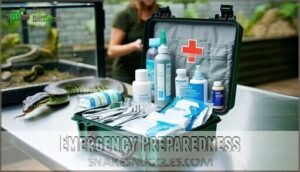This site is supported by our readers. We may earn a commission, at no cost to you, if you purchase through links.
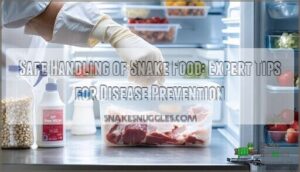 Safe handling of snake food requires treating frozen rodents like raw meat in your kitchen.
Safe handling of snake food requires treating frozen rodents like raw meat in your kitchen.
You’ll want to thaw prey items in the refrigerator, never at room temperature, to prevent bacterial growth that can make both you and your snake sick.
Always wash your hands thoroughly before and after handling food, use dedicated feeding tools instead of your bare hands, and disinfect surfaces where prey items touched.
Store frozen rodents in sealed containers, separate from human food, and never refreeze thawed items.
Think of it this way: if you wouldn’t handle raw chicken carelessly, don’t handle snake food carelessly either.
These simple precautions become second nature once you understand the surprising science behind bacterial prevention, and by following these rules, you can ensure a safe and healthy environment for your snake, which is essential for its well-being, and remember to always prioritize proper handling and safe storage to prevent any potential risks.
Table Of Contents
- Key Takeaways
- Handling Snake Food Safely
- Safe Feeding Practices
- Snake Hook Selection
- Reducing Risk of Disease
- Emergency Preparedness
- Frequently Asked Questions (FAQs)
- What not to do when handling a snake?
- Can I hold my snake 24 hours after feeding Reddit?
- What not to do when feeding a snake?
- Can snakes eat expired frozen rodents safely?
- How long can thawed prey sit out?
- What temperature should prey be when offered?
- Do different snake species need different prey?
- Can you reuse feeding tongs between snakes?
- Conclusion
Key Takeaways
- Thaw prey safely in the refrigerator, never at room temperature – You’ll prevent dangerous bacterial growth that can make both you and your snake sick by keeping frozen rodents below 4°C during the thawing process.
- Treat snake food like raw meat in your kitchen – You should wash your hands thoroughly before and after handling, use dedicated feeding tools instead of bare hands, and disinfect all surfaces that contact prey items.
- Store frozen rodents properly and never refreeze thawed items – You’ll maintain food quality by keeping prey in sealed containers separate from human food and following "first in, first out" rotation systems.
- Use appropriate equipment and emergency preparedness – You should select the right-sized snake hooks for your species, maintain a first aid kit near feeding areas, and have emergency contact information readily available.
Handling Snake Food Safely
You can’t just toss that frozen mouse into your snake’s enclosure and call it dinner—proper food handling prevents dangerous bacteria from turning mealtime into a health crisis.
From storage temperatures to thawing techniques, every step matters when you’re responsible for your snake’s safety and well-being.
Preventing Bacterial Growth
Bacteria love warmth, turning your reptile food into a microscopic playground when temperatures climb.
Warm temperatures transform frozen prey into bacterial breeding grounds faster than you’d expect.
You’ll need to master these thawing methods to keep your snake safe from foodborne illness:
- Refrigerator thawing: Keep frozen rodents below 4°C to slash bacterial growth by 90%
- Cold water baths: Change water every 30 minutes to prevent contamination sources
- Never refreeze: Once thawed mice hit room temperature, bacteria doubles every 20 minutes
Skip countertop thawing—salmonella risk isn’t worth the convenience.
Proper Storage Techniques
Once you’ve controlled bacterial growth, you’ll need proper storage techniques to maintain food quality.
Vacuum-sealing frozen rodents extends shelf life by 30%, while double-bagging prevents cross-contamination. To help prevent spoilage, use airtight containers for maximum freshness.
Always label packaging dates and rotate stock using "first in, first out" systems.
| Storage Factor | Best Practice | Temperature/Duration | Risk Without Proper Method | Quality Impact |
|---|---|---|---|---|
| Freezer Temperatures | Keep below -18°C (0°F) | Consistent cold storage | Freezer burn, nutrient loss | 30% shelf life extension |
| Thawing Methods | Refrigerate overnight | 0-4°C for 8-12 hours | Bacterial growth above 10°C | Safe thawing prevents spoilage |
| Refreezing Dangers | Never refreeze thawed prey | Single thaw cycle only | 50% higher contamination risk | Microbial multiplication |
| Insect Storage | Sealed containers, escape-proof | Room temperature varies | Home infestation, prey loss | Secure containment needed |
| Packaging Dates | Label and track expiration | FIFO rotation system | 40% more expired food waste | Fresh prey quality maintained |
Handling Frozen Rodents
When thawing mice, you’ll want to avoid the microwave – it creates hot spots that can burn your snake’s mouth.
Instead, place frozen rodents in cold water, changing it every 30 minutes until completely thawed.
Never refreeze thawed prey since bacteria multiply rapidly at room temperature, creating serious contamination risks.
Always check rodent quality before feeding.
Safe Feeding Practices
You’ll want to nail the basics of prey selection and feeding schedules to keep your snake healthy and disease-free.
Getting these fundamentals right means fewer vet visits and a happier snake that actually wants to eat when mealtime rolls around, resulting in a better overall experience for both you and your snake.
Choosing Right Prey Size
You’ll want your prey circumference to match your snake’s thickest body part.
When in doubt, smaller prey is always better than oversized meals. Two smaller prey items can safely replace one regular-sized meal if needed.
Baby snakes start with neonate mice, while prey size naturally increases as they grow.
Getting meal size right prevents regurgitation and keeps your snake healthy.
Feeding Frequency Guidelines
After sizing your prey correctly, you’ll need to master feeding schedules. Most adult snakes thrive on weekly meals, but age matters substantially – juveniles need food every five to seven days while adults can wait longer. Species differences affect meal frequency too.
- Juvenile snakes grow rapidly – they’ll literally starve without frequent feeding schedules
- Adult ball pythons can fast for months – their slow metabolism amazes even experienced keepers
- Overfeeding risks obesity – a chubby snake isn’t a healthy snake
- Captive vs wild feeding differs drastically – your pet doesn’t hunt for survival
- Health status changes everything – sick snakes need adjusted snake feeding frequency
Recognizing Refusal Signs
When your snake turns its nose up at dinner, you’re witnessing snake feeding refusal—a clear behavioral change that signals something’s amiss.
Your snake’s dinner rejection isn’t just picky eating—it’s an important health signal you can’t ignore.
Watch for spitting out prey, lack of interest, or complete avoidance. These snake feeding refusal signs often point to illness indicators like insufficient warmth issues or environmental stress.
Poor snake feeding digestion from previous meals can also trigger refusal. Monitor your snake’s feeding behavior closely, as stress factors and warmth issues frequently cause feeding problems.
Maintaining proper hygiene practices can also prevent feeding issues.
Snake Hook Selection
When you’re handling snake food, the right hook becomes your best friend for keeping both you and your snake safe.
You’ll want to choose a hook that matches your snake’s size and your comfort level – too short and you’re playing with fire, too long and you’ll lose the finesse needed for gentle handling, which is crucial for maintaining safety and control, with the hook being a critical tool in this process.
Choosing The Right Hook
When selecting snake hooks, you’ll want equipment that keeps you safe while reducing stress on your snake.
The right hook becomes an extension of your arm, making handling smooth and controlled.
Here are 5 key factors for choosing snake handling tools:
- Hook Length – Match the hook to your snake’s size and temperament; longer hooks (36+ inches) work best for large constrictors, while 12-18 inch hooks suit juveniles perfectly.
- Handle Grip – Look for non-slip, textured grips that prevent drops in humid conditions and reduce hand fatigue during extended handling sessions.
- Hook Angle – Classic U-shaped hooks distribute weight evenly, while flat-edged designs provide extra stability for heavy-bodied species.
- Tip Shape – Rubber-tipped or polymer-coated tips reduce scale damage by 60% compared to bare metal, making them gentler on sensitive snakes.
- Weight Balance – Well-balanced handling equipment prevents operator fatigue and maintains precise control, especially important when working with defensive species.
Professional herpetologists recommend stainless steel snake hooks for their durability and corrosion resistance in humid environments.
Consider the appropriate hook length for ideal safety.
Hook Size Considerations
Your snake’s size directly determines the appropriate hook length – larger snakes need longer snake hooks for safe distance.
A 24-inch hook works for most ball pythons, while smaller species like corn snakes handle well with 18-inch tools.
Hook weight matters too; heavier snake handling equipment provides better control but increases fatigue during extended sessions.
Match your handling style with appropriate snake handling tools – beginners benefit from longer, lighter hooks.
Consider storage solutions when selecting length, as longer snake handling equipment requires more space.
For venomous species, it’s vital to prioritize increased safety distance to ensure handler safety with safe distance.
Material and Durability
Quality materials make the difference between a hook that lasts years versus one that breaks mid-handling.
Stainless steel offers superior material strength and chemical resistance, making cleaning ease a breeze after handling frozen mice.
Look for temperature tolerance that handles both rodent storage conditions and your snake room’s heat. A hook with good lifespan expectancy saves money and guarantees reliable food safety when working with frozenthawed rodents from any rodent source, ensuring good lifespan.
Reducing Risk of Disease
You’ll want to protect yourself and your snake from harmful bacteria and pathogens that can lurk on prey items and feeding equipment.
Proper hygiene practices create a barrier between you and potential diseases while keeping your snake’s environment clean and safe.
Handwashing Techniques
After selecting the right snake hook, proper hygiene becomes your strongest defense against disease transmission.
You’ll want to wash your hands thoroughly before and after handling any snake food or equipment. This simple practice prevents cross-contamination and maintains safe handling practices throughout your feeding routine.
Remember to practice strict hygiene measures to minimize risks.
- Soap Selection: Use antibacterial soap with at least 60% alcohol content for maximum effectiveness against pathogens
- Water Temperature: Warm water opens pores and helps soap penetrate deeper, removing more bacteria than cold water
- Scrubbing Duration: Wash for minimum 20 seconds, focusing on fingernails and between fingers where germs hide
- Drying Methods: Use clean paper towels rather than cloth towels to avoid recontamination after proper hand washing
Disinfecting Surfaces
Clean surfaces remove 60% more bacteria than dirty ones before applying your bleach solution.
Choose EPA-registered disinfectant types like quaternary ammonium compounds for proper hygiene.
Verify five-minute contact time on feeding areas to prevent crosscontamination.
Rinse surface materials thoroughly after disinfecting—residue removal protects your snake from chemical irritation.
These handling safety protocols maintain safe handling practices year-round.
Many use specific disinfectant products for reptiles.
Using Dedicated Utensils
Dedicated feeding tongs prevent cross-contamination between your hands and snake food, reducing pathogen transfer substantially.
Choose appropriately sized feeding tools that match your snake’s dimensions—larger tongs for bigger species, smaller ones for juveniles.
Rubber-tipped tongs offer superior grip while protecting delicate prey items.
Regular utensil cleaning with disinfectant eliminates harmful bacteria, ensuring feeding safety tips work effectively for long-term snake health.
Emergency Preparedness
Even experienced snake keepers can face unexpected emergencies during feeding time, making preparation your best defense against accidents.
You’ll want emergency contacts ready, a well-stocked first aid kit nearby, and a clear action plan before any feeding session begins.
Dealing With Bites
When snake bites happen, bite severity depends on the species and your reaction speed.
Apply basic first aid immediately—clean the wound, control bleeding, and stay calm. Don’t attempt amateur surgery or tourniquets.
Identifying snakes helps medical professionals determine antivenom access needs.
Focus on bite prevention through proper snake handling techniques and safety gear during snake feeding sessions to ensure safety.
Having Emergency Plans
Beyond handling snake bites properly, you’ll need a thorough emergency plan that covers various scenarios.
Your emergency response should include detailed bite protocols, verified antivenom access locations, and updated contact lists for veterinary professionals.
- Create evacuation routes for quick hospital transport during medical emergencies
- Maintain current contact lists with local exotic veterinarians and poison control centers
- Document your snake escape plan with containment procedures and hazard assessment protocols
Keeping First Aid Kits
Assembling thorough kit essentials ensures you’re prepared when snake feeding safety meets Murphy’s Law.
Your first aid kit should include clean bandages, antiseptic solution, and emergency contact numbers for immediate wound care after snake handling snake bites.
A vital addition involves having a specialized treatment readily to address potential issues.
Position your kit location near feeding areas for quick antivenom access, and establish clear bite protocols that prioritize emergency response over panic.
This ensures that you are well-prepared to handle any situation that may arise, with a focus on emergency response to minimize risks.
Frequently Asked Questions (FAQs)
What not to do when handling a snake?
Never handle your snake within 48-72 hours after feeding—you’ll risk dangerous regurgitation.
Don’t grab suddenly or squeeze tightly, as this causes stress and defensive strikes.
Avoid handling during shedding cycles when snakes feel vulnerable.
Can I hold my snake 24 hours after feeding Reddit?
Wait—you’re tempted to handle your snake just 24 hours post-meal.
Don’t risk it. You’ll need 48-72 hours minimum for proper digestion, preventing regurgitation and stress that could harm your snake’s health.
What not to do when feeding a snake?
Don’t handle your snake for 48-72 hours after feeding to prevent regurgitation.
Avoid offering oversized prey that’s thicker than your snake’s widest body section, as this causes digestive stress and potential health complications.
Can snakes eat expired frozen rodents safely?
When the chips are down, you can’t safely feed your snake expired frozen rodents. Bacteria multiply rapidly in thawed, expired prey, causing serious digestive infections that’ll harm your pet’s health.
How long can thawed prey sit out?
Thawed prey shouldn’t sit out for more than two hours at room temperature before becoming unsafe.
You’ll risk dangerous bacterial growth that could make your snake seriously ill if you wait longer than this window.
What temperature should prey be when offered?
Most snakes prefer prey warmed to body temperature, around 98-100°F. You’ll want to warm thawed prey in warm water for 10-15 minutes before offering it to your snake.
Do different snake species need different prey?
Yes, different snake species require different prey types and sizes.
You’ll need to match prey to your snake’s natural diet – ball pythons eat rodents, while some species prefer birds, fish, or insects depending on their evolutionary adaptations.
Can you reuse feeding tongs between snakes?
You shouldn’t reuse feeding tongs between snakes without proper disinfection. Clean them with at least a 1:30 bleach solution between each snake to prevent spreading pathogens and diseases.
Conclusion
Apparently, your snake won’t appreciate your kitchen’s five-star dining experience if you’re serving contaminated rodents with a side of salmonella.
Following proper safe handling of snake food protocols protects both you and your pet from preventable illnesses.
You’ve learned essential techniques for thawing, storing, and preparing prey items safely.
Remember to maintain consistent hygiene practices, use dedicated tools, and treat frozen rodents like any raw meat.
These habits become routine with practice and guarantee your snake’s health.



